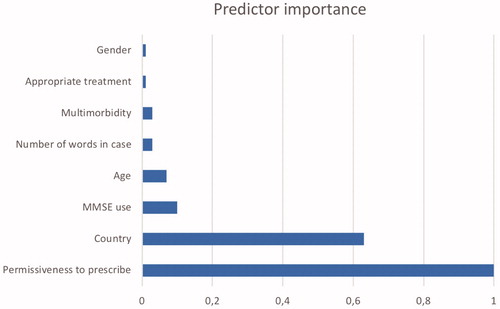Figures & data
Table 1. The basic social process of Unburdening Dementia.*
Table 2. Demographics, dementia prevalence, grades of dementia drug prescribing permissiveness in the participating countries and share of dementia drugs prescribed in the case stories per region.
Figure 1. Importance of predictors of primary care physician involvement in dementia work-up and treatment. Degree of involvement is dichotomised into two groups by a two-step cluster analysis. Cluster analysis is an exploratory method to identify structures within the data such as homogenous groups of cases if grouping is not previously known. ‘Exploratory’ means that it makes no distinction between dependent and independent variables. We used the SPSS Version 22 two-step cluster analysis. The most important predicting variables to allocate the informants in the two groups were ‘permissiveness to prescribe dementia drugs’ (Predictor importance PI = 1) and ‘country’ (PI = 0.61). All the other variables had a PI of < 0.02. Permissiveness: official permissiveness to prescribe typical dementia drug reimbursed by the local health care system. Country: country of the case and his/her primary care physician. Appropriate treatment: appropriate treatment according to the dementia guidelines and the label indication. Age: age of the case in years. Gender: gender of the case. MMSE: mini mental state examination. Number of words in case: word count in the case description.

Table 3. Dementia drug treatment stratified by diagnostic group.
Data availability statement
All data generated or analysed during this study are included in this published article and its supplementary information files as well as in reference [Citation10]. The datasets analysed during this study will be available from the corresponding author on reasonable request.
